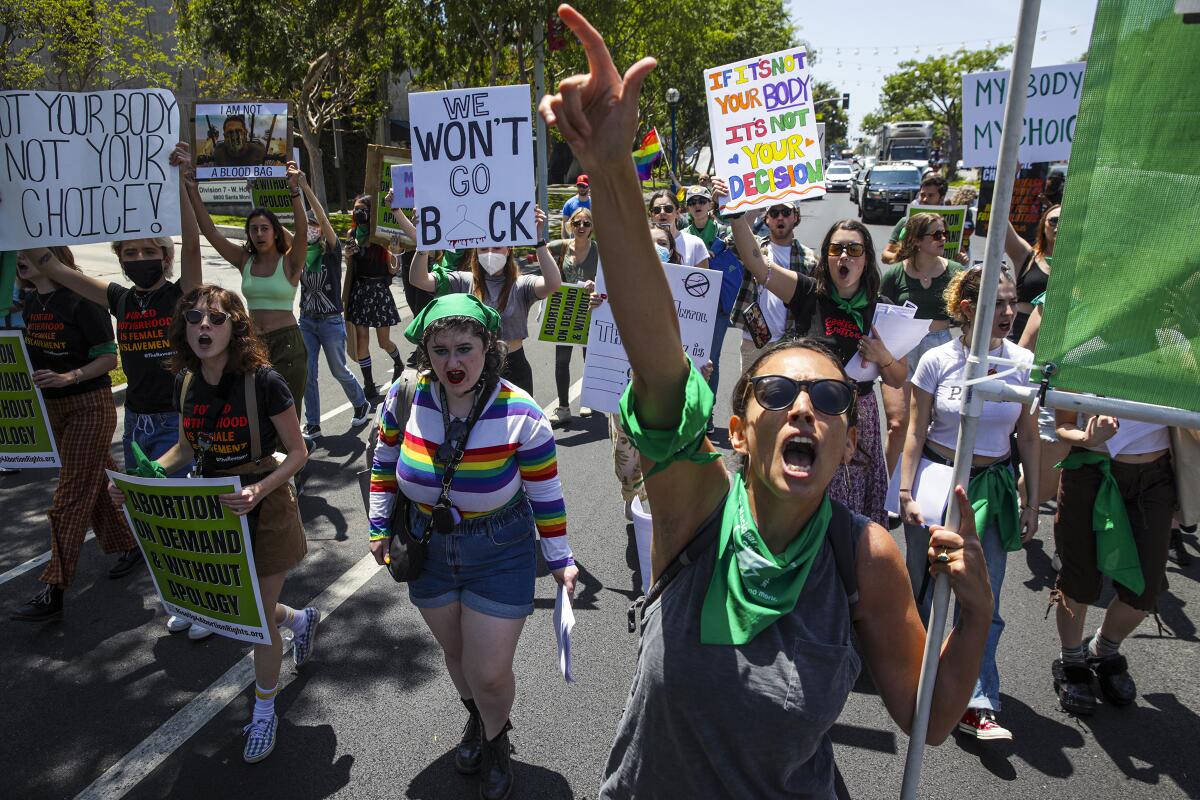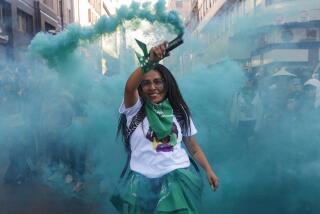How the green bandanna became a symbol of the abortion rights movement

- Share via
MEXICO CITY — It is a ubiquitous symbol at abortion rights rallies across Latin America: the bright green bandanna.
So many protesters wear the bandannas on their heads or around their necks or wrists that the recent loosening of abortion restrictions across the region has become known as the “green wave.”
These days, the bandanna is also showing up in the United States.
From outside the Supreme Court in Washington to downtown Los Angeles, crowds protesting last week’s reversal of Roe vs. Wade have been dotted with green.
“The green as a symbol carries international inspiration of the fight that women have waged across the world for the right to an abortion,” said Michelle Xai, a 29-year-old organizer in New York for Rise Up 4 Abortion Rights, a coalition that formed in January.
At a rally this week outside the federal courthouse in downtown L.A., activists read statements from counterparts in Peru, Argentina and Brazil calling on U.S. politicians to take action.
The green bandanna made its debut in 2003 in the Argentine city of Rosario when the abortion rights group Catholics for the Right to Decide enlisted women’s sewing cooperatives to produce 3,000 of them for distribution at a women’s march.
Marta Alanis, 73, a founder of the organization, said green — “the color of nature” — was chosen because it “signifies life and we’re confronted by a sector that calls itself pro-life and robs us of the word.” The group also wanted to avoid the colors of the Argentine flag or those associated with political movements.
“We couldn’t have imagined the dimension that the green handkerchief would take on,” she said. “It was a five-minute conversation. It’s not like there was a grand debate.”
The concept was also inspired by the Mothers of the Plaza de Mayo in Argentina, who wore white bandannas to call attention to their children who were kidnapped during the military dictatorship that ruled the country between 1976 and 1983.
In 2005, a new nationwide abortion rights coalition designated the green bandanna the official symbol of its campaign.
“It became a symbol of our struggle,” said Nina Brugo, a 78-year-old pioneer of the country’s abortion movement. “It was the way to get together to march.”
The bandanna became more prominent as Argentina’s abortion rights campaign gained momentum.
Activists distributed more than 200,000 handkerchiefs in 2018, the year that tens of thousands of women took to the streets of Buenos Aires in a massive protest. Two years later, Argentina’s Congress legalized abortion up to the 14th week of pregnancy.
Other countries have followed suit. In 2021, Mexico’s Supreme Court voted to decriminalize abortion. Colombia’s Constitutional Court followed this year, legalizing abortion until the 24th week of pregnancy. In Chile, a draft of a new constitution to be voted on this year has a clause that would safeguard abortion rights.
In all of those countries, activists have used the green handkerchiefs as an organizing tool.
Ana Cristina González Vélez, a leader in the abortion rights movement in Colombia, said people “associate it with a global fight, which is the fight of all women in the world for reproductive freedom.”
More to Read
Sign up for Essential California
The most important California stories and recommendations in your inbox every morning.
You may occasionally receive promotional content from the Los Angeles Times.











